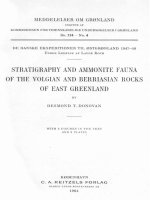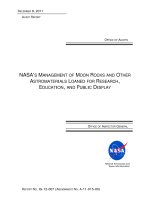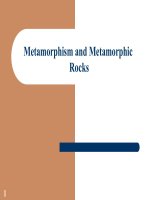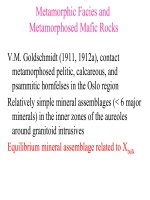Metamorphism, metamorphic rocks, and hydrothermal rocks
Bạn đang xem bản rút gọn của tài liệu. Xem và tải ngay bản đầy đủ của tài liệu tại đây (2.01 MB, 14 trang )
Metamorphism, Metamorphic
Rocks, and Hydrothermal Rocks
Chapter 7
Metamorphic gneiss from Greenland, 3.7 Ba
Metamorphic Rocks
• Metamorphism refers to solid-state
changes to rocks in Earth’s interior
– Produced by increased heat, pressure, or
the action of hot, reactive fluids
– Old minerals, unstable under new
conditions, recrystallize into stable ones
• Rocks produced from pre-existing or
parent rocks in this way are called
metamorphic rocks
bread
toast
Metamorphic Rocks
• Metamorphic rocks common in the old, stable cores of
continents, known as cratons
*Oldest stable continental core
*Seismically fast
*Geothermally cold
*Buoyant – low density (chemically depleted)
Factors Controlling Metamorphic Rock
Characteristics
• Texture and mineral content of metamorphic
rocks depend on:
–
–
–
–
Parent rock composition
Temperature and pressure
Effects of tectonic forces
Effects of fluids, such as water
Factors Controlling Metamorphic Rock
Characteristics
• Temperature during metamorphism
– Heat for metamorphism comes from Earth’s deep interior
– If temperature gets high enough, melting will occur
• Pressure during metamorphism
– Confining pressure applied equally in all directions
– Pressure proportional to depth within the Earth
• increases ~1 kilobar per 3.3 km of burial within the crust
1 kb = 14,500 psi
and
VW bug = 2000 lbs
Pressure at 100 km depth = 239 VW Bugs on 1 square inch area
(A bigger area of 1 sq foot would require 34,452 VW bugs!)
Characteristics of Metamorphic Rock
• Tectonic forces
– Often lead to forces that are not equal
in all directions (differential stress)
– Compressive stress causes flattening
perpendicular to stress
– Shearing causes flattening by sliding
parallel to stress
– Planar rock texture of aligned
minerals produced by differential
stress is known as foliation
Deformation of Metamorphic Rock
• Fluids
– Hot water (as vapor) is most important,
– Rising temperature causes water to be released from
unstable minerals
• Time
– Metamorphism, particularly from high pressures, may
take millions of years
– Longer times allow newly stable minerals to grow
larger and increase foliation
Metamorphic Rock Classification
• Classification based on rock texture
– Foliated (layered) vs. non-foliated (non-layered)
– Foliated rocks named based on type of foliation (slaty,
schistose, gneissic)
– Non-foliated rocks named based on composition
limestone
marble
granite
Foliated gneiss
Types of Metamorphism
• Contact metamorphism
– High temperature
– Produces non-foliated rocks
marble
– Rocks come in contact with magma
bodies intruding cooler country rock
quartzite
Types of Metamorphism
• Regional metamorphism
–
–
–
–
High pressure
Results in rocks with foliated textures
Can deform in mountain ranges
May occur over wide temperature range
Types of Metamorphism
• Regional metamorphism
– Higher pressure and temperature will produce
increased metamorphic grade
– Prograde metamorphism of shale produces:
•slate
•phyllite
•schist
•gneiss
slate
phyllite
schist
gneiss
Types of Metamorphism
• Partial melting during metamorphism
produces migmatites
– Migmatites exhibit both intrusive igneous
and foliated metamorphic textures
• Shock metamorphism is produced by
rapid application of extreme pressure
– Meteor impacts produce this
– Shocked rocks are found around and
beneath impact craters
Plate Tectonics and Metamorphism
• Regional metamorphism associated with convergent plate
boundaries
– Pressure proportional to depth
– Temperature varies laterally at convergent boundaries
•Isotherms bow down in sinking oceanic plate and bow up where magma
rises
Hydrothermal Processes
• Rocks precipitated from or altered by hot
water are referred to as hydrothermal
– Common at spreading centers (under water)
• Hydrothermal processes add water for
metamorphic reactions
• Formation of hydrothermal rocks
• Water passes through rocks and precipitates new
minerals on walls of cracks and in pore spaces
• Metallic ore deposits often form this way (veins)









